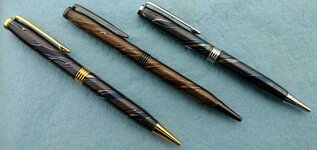There are many different patterns and approaches to making Damascus or watered steel, including Wootz steel and crucible steel, which create amazing and random patterns running through the metals.
You can combine various types of steels with pure iron as well as pure nickel ... so long as the metals and alloys have a similar range for melting and welding temperatures so that they can bond to each other. Just always keep in mind when working with stainless steels and nickel or nickel stainless .... nickel does NOT like to be welded to itself, and the welds will typically fail. A trick to get around an issue like that is to grab a shim of pure iron to lay between the nickel faces to get them to weld ... ideally, the iron would end up being practically invisible in that arrangement.
You are not limited to just 2 metals in a Damascus steel billet ... the only limitations you have are the limits to your own imagination.
I read a good book several years ago, part of the 4-book Inheritance Cycle (also known as Eragon) ... in the third book, the author goes in-depth into the process of forge welding the main character's new sword, from smelting the original ore right down to the final shaping, polishing, and coloration of the blade. The attention to detail was impressive, and I discovered on reading the author's notes at the end of the book that his interests also lay in metalworking, and that the account was as accurate as he could make it, given his research into bladesmithing and his own personal experience in that field. This sparked my own interest in this field and my personal journey into the world of the blacksmith's forge.

